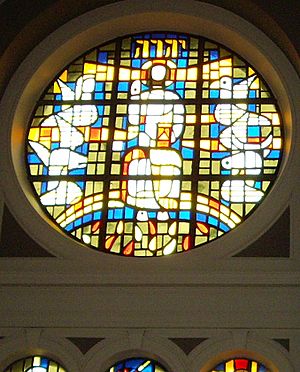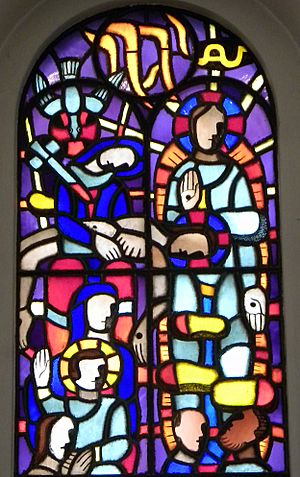Erik Olson facts for kids
Erik Artur Olson (1901–1986) was a famous Swedish artist. He was a painter, illustrator, and sculptor. Erik was also a member of a special art group called Halmstadgruppen. He is best known for his unique surrealist artworks. These paintings often looked like dreams.
Contents
Who Was Erik Olson?
Erik Olson was born in Halmstad, Sweden, on May 9, 1901. He was the brother of another artist, Axel Olson. In 1929, he married Solvig Sven-Nilsson. Erik Olson's art can be seen in important museums. These include the National Museum and the Museum of Modern Art.
Erik's Early Life and Art
Erik grew up in Halmstad. After finishing school, he worked in an office copying documents. In the evenings, he focused on his main interest: drawing and painting. He studied at the Halmstad Technical School. His father hoped Erik would become an engineer.
However, Erik and his older brother Axel Olson loved art. Their cousin Waldemar Lorentzon also shared this passion. In 1919, they all showed their art in a local exhibition. That summer, they met a well-known artist named Gosta Adrian-Nilsson (GAN). GAN's paintings and ideas greatly inspired them.
Learning Art in Paris
In 1924, Erik Olson traveled to Paris with Waldemar Lorentzon. They studied at Fernand Léger's art school, Academie Moderne. Here, they learned about cubism. Cubism is an art style where objects are broken up and put back together in different ways.
From late 1924 to early 1925, Erik went to Italy to study more art. After his military service, he returned to Paris in 1927. He continued to work with Léger. In 1929, he married the painter Solvig Sven-Nilsson.
The Halmstad Group and Surrealism
In 1929, Erik Olson helped start the Halmstadgruppen. This was an important art group in Sweden. In late 1930, he painted a work called 'Handsken är kastad' (The Glove is Thrown). Many people consider this his first surrealist painting.
Surrealism is an art movement that started in the 1920s. Surrealist artists try to show the world of dreams and the unconscious mind. Their art often looks strange or dream-like. Erik Olson became known as a Swedish surrealist because of this style.
Later Life and Religious Art
Erik Olson lived in France and Denmark for some time. From the 1930s, his art was shown in many exhibitions. These shows took place in cities like Copenhagen, London, Paris, and New York. He often spent his summers on the coast of Halland. There, he joined an artist group called Söndrumskolonin in the 1940s.
In 1950, Olson became a Catholic. In his later years, he explored religious art. He created beautiful stained glass windows for churches. One example is the window in the Sofia Albertina church in Landskrona. He also made windows for the St. Maria Catholic church in Halmstad. In 1971, Erik Olson received the Prince Eugen Medal. This is a special award for artists in Sweden.



